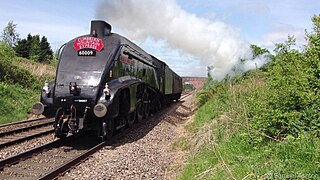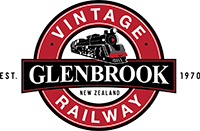
A heritage railway or heritage railroad is a railway operated as living history to re-create or preserve railway scenes of the past. Heritage railways are often old railway lines preserved in a state depicting a period in the history of rail transport.

The Ferrymead Railway is a New Zealand heritage railway built upon the track formation of New Zealand's first public railway, from Ferrymead to Christchurch, which opened on 1 December 1863. On the opening of the line to Lyttelton on 9 December 1867, the Ferrymead Railway became the Ferrymead Branch and was closed shortly thereafter. In 1964, rail enthusiasts began relaying track on the historic formation and the new 3 ft 6 in narrow gauge. Ferrymead Railway officially reopened in 1977. It now operates steam, diesel and electric trains regularly and is recognised as one of the most significant rail preservation sites in New Zealand.

Railway preservation in New Zealand is the preservation of historically significant facets of New Zealand's rail transport history. The earliest recorded preservation attempt took place in 1925, although the movement itself did not start properly until 1960.

Methil is an eastern coastal town in Scotland. It was first recorded as "Methkil" in 1207, and belonged to the Bishop of St Andrews. Two Bronze Age cemeteries have been discovered which date the settlement as over 8,000 years old. Famous for its High Street that used to have the most pubs per mile in Scotland, it was part of its own barony in 1614 and also part of the former burgh of Buckhaven and Methil. This burgh existed between 1891 and 1975. It is situated within a continuous urban area described as Levenmouth.
The Canterbury Railway Society is an organisation of railway enthusiasts based in the Canterbury region of New Zealand's South Island, best known for their operation of The Ferrymead Railway at the Ferrymead Heritage Park.

The Royal Deeside Railway is a Scottish heritage railway located at Milton of Crathes railway station on a part of the original Deeside Railway.
Leven is a seaside town in Fife, set in the east Central Lowlands of Scotland. It lies on the coast of the Firth of Forth at the mouth of the River Leven, 8.1 miles (13.0 km) north-east of the town of Kirkcaldy and 6.4 miles (10.3 km) east of Glenrothes.

60009 Union of South Africa is a LNER Class A4 steam locomotive built at Doncaster Works on 16 April 1937. It is one of six surviving A4s. Its mainline certification expired in April 2020. As the locomotive is subject to a boiler inspection, it was moved to the East Lancashire Railway as the original plan was to keep it running there until the end of boiler certificate and then send it somewhere else for static display, but a cracked boiler tube forced it into retirement prematurely. It was briefly renamed Osprey during part of the 1980s and 1990s due to political opposition against apartheid in South Africa at the time.

The Cambrian Heritage Railways is a heritage railway company, trust and society based at both Llynclys and Oswestry in its newly restored Oswestry railway station, Shropshire, England.

The Fife Circle Line is the local rail service north from Edinburgh. It links towns of south Fife and the coastal towns along the Firth of Forth before heading to Edinburgh. Operationally, the service is not strictly a circle route, but, rather, a point to point service that reverses at the Edinburgh end, and has a large bi-directional balloon loop at the Fife end.
The Scottish Region (ScR) was one of the six regions created on British Railways (BR) and consisted of ex-London, Midland and Scottish Railway (LMS) and ex-London and North Eastern Railway (LNER) lines in Scotland. It existed from the creation of BR in 1948, and was renamed to ScotRail in the mid-1980s.
A railtour is a special train which is run in order to allow people to experience rail travel which is not normally available using timetabled passenger services. The 'unusual' aspect may be the route of the train, the destination, the occasion, specific sections of railway track, the locomotive hauling the train, the rolling stock, or any combination of these. Organisers may own or hire locomotives or rolling stock, or tours may be organised by railway management or other bodies outside the railway fraternity. Perhaps the most famous railtour in England was the Fifteen Guinea Special, the last steam hauled main line train run by British Rail. Railtours are often identifiable through the use of a train headboard, often identifying the name of the specific tour or the tour operator. On TOPS, railtours are usually given a 1Zxx headcode. Exceptions to this rule include regularly scheduled railtours such as the Belmond British Pullman operated Venice-Simplon Orient Express trains.

The Glenbrook Vintage Railway (GVR) is a heritage steam railway in Glenbrook, New Zealand.
Levenmouth is a conurbation comprising a network of settlements on the north side of the Firth of Forth, in Fife on the east coast of Scotland. It consists of three principal coastal towns; Leven, Buckhaven, and Methil, and a number of villages and hamlets inland. The industrial towns of Buckhaven and Methil lie on the west bank of the River Leven, and the resort town of Leven is on the east bank. The "Bawbee Bridge" links the two sides of the river. Historically, Buckhaven and Methil were joined together as one burgh, while Leven was separate. The area had an estimated population of 37,238 in 2006.

Milton of Crathes railway station is located at Milton of Crathes, three miles east of Banchory, Royal Deeside, Aberdeenshire, Scotland, United Kingdom.
The Levenmouth rail link is a planned scheme to re-open 5 miles (8 km) of railway line in Fife, Scotland. The link will connect the town of Leven and other settlements in the Levenmouth conurbation with Thornton, and will join the Fife Circle Line at Thornton North Junction. The line is being promoted by Fife Council and the South East Scotland Transport Partnership (SESTRAN). The plan was approved by the Scottish Government on 8 August 2019. The project is due to be completed with the railway line opening on 2 June 2024.

The Waitara Railway Preservation Society is a society established in 1999 to operate a heritage railway over the former Waitara Industrial Line railway that operated between Lepperton and Waitara in the New Plymouth District of New Zealand's North Island. The line had been closed that year after 124 years of operation, after the closure of the local AFFCO freezing works in the town.
The East Fife Central Railway was a mineral railway line in Fife, Scotland, that ran from near Leven to Lochty. It was built to develop extensive coal measures in the area. The line was completed by the North British Railway and it opened in 1898.
The Fife Coast Railway was a railway line running round the southern and eastern part of the county of Fife, in Scotland. It was built in stages by four railway companies:
The Wemyss and Buckhaven Railway was a railway company that built a line in the county of Fife in Scotland, connecting Buckhaven with the main line railway network at Thornton, and linking with collieries.




























